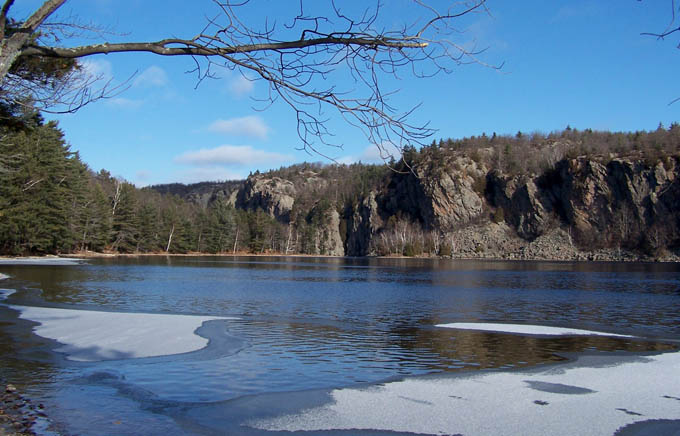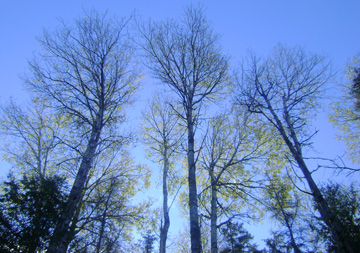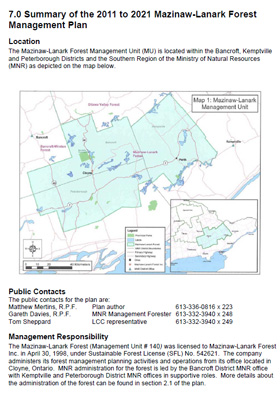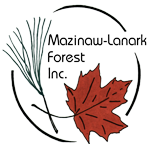Forest Management Planning
The forest management plan is prepared in accordance with the provisions of the Forest Management Planning Manual (FMPM). The planning manual prescribes the requirements for Ontario’s forest management planning system including the planning process and products. The forest management plan describes the forest management objectives and strategies for the Mazinaw-Lanark Forest. The plan also outlines how forest management on the unit has regard for the plant life, animal life, water, soil, air, and social and economic values, including recreational values and heritage values.
A link to the 2009 version of the Forest Management Planning Manual along with a good description about forest management plans is found at the following link to the Ontario Ministry of Natural Resources and Forestry’s website:
Forest Management Policies - Ontario
Public Consultation
Public consultation is a major component of the planning process. A planning team is appointed to be a working body in the preparation of the plan. The team is comprised of members who have expertise in forest management, information management, fish and wildlife, species at risk, biology, and other related disciplines. A local citizens committee assists the plan author and the planning team during the production of the forest management plan. The Local Citizens Committee represents a range and balance of local interests and ensures that these interests are communicated to the planning team. The Local Citizens Committee may nominate a member to participate on the planning team. Below is a link to a brochure produced by the Ministry of Natural Resources and Forestry which explains how to get involved in Ontario’s forest management planning process.
Help shape the future of our forests: an introduction to the forest management planning process
The Planning Process and Consultation
The planning process in Ontario is completed in two phases. Phase I consists of five stages and involves the development of the long-term management direction and operational planning for the first five years of operations in the plan. Phase 2 consists of three stages of public consultation where operational planning for the second five years of operations is completed. During each stage of consultation, the public may review material produced for the requirements of the planning manual. Some phases consist of a public open house and others are simply an opportunity for the public to access information relating to the development of the forest management plan.
2021-2031 Mazinaw-Lanark Forest Management Plan
The 2021-2031 Forest Management Plan for the Mazinaw-Lanark Forest was prepared by Mazinaw-Lanark Forest Inc. by following the 2009 Forest Management Planning Manual. A copy of this plan can be accessed through the Ontario Ministry of Natural Resources and Forestry website at:
https://nrip.mnr.gov.on.ca/s/fmp-online?language=en_US
Once you navigate to this page select Mazinaw-Lanark Forest in the drop-down menu under “Find a Plan”. Alternatively, you may click on the forest management unit that you are interested in on the map of Management Units in Ontario on the same webpage.
Reflecting provincial policy, the forest management plan outlines the strategic and operational direction for forest operations on Mazinaw-Lanark Forest. Strategic direction in the plan also referred to as the “Long-term Management Direction” provides guidance for the levels of access, harvest, renewal, and tending activities to achieve the desired future forest and benefits. Management objectives and indicators, such as for wood supply, are developed to measure progress towards the desired future forest and the many benefits of managing the forest.
Operational planning in the forest management plan identifies the areas proposed for harvest, the methods which are used to regenerate the harvest areas, as well as the buffers that are employed to reduce impacts to forest values. The forest management plan identifies protection for a list of values including:
- Water bodies and hydrological linkages - lakes and streams
- Biodiversity such as species at risk, fish, and wildlife
- Parks and Protected areas
- Roads and public access
- Lakes with significant human values and use
- Forest productivity - standards to prevent erosion and rutting
- Human history – archaeological sites
- Forest history – old growth and unique forest areas
- Remote access areas

A more detailed description of the plan is included in the following summary of the forest management plan.
 Mazinaw-Lanark Forest Inc. Forest Management Planning
Mazinaw-Lanark Forest Inc. Forest Management Planning
